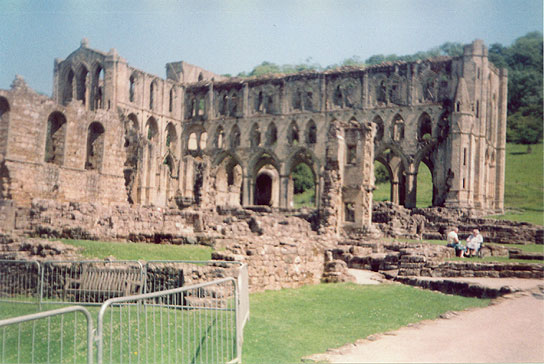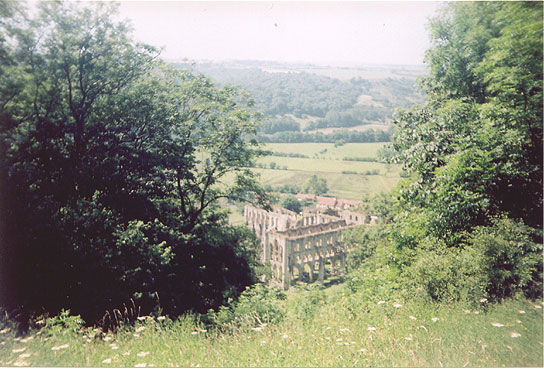National Trust
The site is an artificial terrace of serpentine form, on a wooded escarpment overlooking the ruins of Rievaulx Abbey. Wide lawns are framed by banks of luxuriant flowers, and at either end of the terrace is a small temple. The Doric or Tuscan temple has flooring from the Abbey, and the Ionic temple at the other end was intended as a banqueting house and has elaborate interior décor. There is an exhibition in the Ionic Temple basement, in the former kitchen quarters. The terrace was constructed for Thomas Duncombe III, from the same family who owned Duncombe Park a mile away. Duncombe Park also has a formal terrace and temples, constructed earlier in about 1730.
The gardens are very pleasant, and worth a visit if you are touring in the area. Other attractions, e.g. Duncombe Park, Nunnington Hall, are nearby. In theory, the site overlooks the nearby Rievaulx Abbey below, but in practice the view (in 2005) is severly restricted by tree growth.
Category: North
location
Rievaulx Abbey, Yorks.

The abbey ruins lie in a quiet valley and large parts of the church survive to their original height. There are substantial ruins of other monastery buildings. The site has yielded much archaeological evidence about abbey life, and there is an indoor exhibition. There is an audio tour.
Well worth a visit if you are touring in the area.
In theory, the site is overlooked by the nearby Rievaulx Terrace above, but in practice the view (in 2005) is severly restricted by tree growth.

York Minster
Or, in plainer English, York Cathedral.
One of the great cathedrals of Europe; a fabulous medaeval Gothic building. Even if you are not particularly interested in architecture or religion, don’t miss this if you are in the area. You’ll be impressed by this soaring creation of intricately carved stone. It shows what our ancestors thought was worth spending effort and money on – while the peasants lived in fetid huts, God and his servants got to use a building like this. And yes it has its own website: York Minster.
Richmond Castle, Yorks.
English Heritage
Richmond Castle stands on a rocky promontory above the River Swale, and overlooking the picturesque old town of Richmond. The castle is Norman, and the towering keep is unusually complete. Visitors can climb up inside it for panoramic views over the castle’s great courtyard, the wide cobbled market place of Richmond, and the land beyond. There is an exhibition space, and a garden, its origins contemporary with the castle, on a terrace overlooking the River Swale. Inside the circuit of walls is a broad spread of green, with the vertical lines of the well-preserved keep soaring above.
The castle is well worth a visit if you are touring in the area. The castle is in the town and there is no dedicated parking. It was here that I encountered the parking-disk system used in North Yorkshire, that involves obtaining a free cardboard disk from a shop (etc), setting your time of arrival, and leaving it on view in your car.
The old town itself is also interesting, as I recall.
Pickering Castle, Yorks.
English Heritage
An interesting castle built on top of a mound surrouded by a deep ditch, obviously a replacement for a Norman wooden + earthwork fortification. Much remains of the outer circuit of walls surrounding the ditch, but not so much of the stone keep. There are views from the top of the mound.
Worth a visit if you are touring in the area.
Ormesby Hall, Yorks.
National Trust
The hall is built of weather-stained stone in a notably plain Palladian style. Originally it was in open countryside but now the suburbs of Middlesborough have encroached on the estate. The two-story service wing on the east was formed out of the earlier Jacobean house. Inside, the interior of the main block, which has some rich plaster decoration and woodwork carving, is a complete contrast to the plain exterior. The service wing contains a fully equipped Victorian laundry. Outside, there is an attractive garden. The fine Georgian stable block is home to the horses of the Cleveland mounted police. A Model Railway group is based at the Hall in the old wing, with three permanent layouts on view.
I found that visiting the Hall was worth a rather tedious drive to reach it.
North Yorks Moors Railway
A preserved steam railway.
The line runs 18 miles from Pickering to Grosmont, with a total of five stations. There is a connecting service onwards to Whitby on the coast, also apparently steam hauled. Network Rail trains serve Whitby and Grosmont too, but the tickets may not be valid on both services. For the enthusiast, the stock book lists about a dozen each of steam and diesel locos, and several dozen coaches and wagons.
The website says that on some dates services are available along the Esk Valley line, which runs from Whitby via Grosmont to Battersby – a 24 mile run, but I couldn’t find any timetable, so if you are interested you should telephone them.
FYI, the Esk Valley line is normally used for the Network Rail Whitby-Middleborough service.
Of the stations, Pickering is a tourist destination, with a castle, Goathland is the film set for “Aidensfield” in a well-known TV series, and Whitby is a port and seaside resort, and folk festival venue. The NYMR base is at Grosmont.
I remember breaking my journey at Goathland for a lengthy walk which stretched my enthusiasm for walking far beyond its limits as I tried to reach some now-forgotten goal. There is a pretty gorge with waterfall near Goathland which is a popular destination for walkers if I remember correctly.
As for the train trip, I was somewhat disappointed to discover that the line lies mostly in wooded valleys with no view of the moors. You can see more of the scenery by driving the A169 from Pickering to Whitby (or at least your passengers will :-).)
This railway is worth a visit whether your interest is fired by tourism or a passion for steam trains.
Mount Grace Priory, Yorks.
English Heritage
In a grassy space are substantial ruins of the small priory church, and of the four-room cells inhabited by the monks. One of the cells has been restored and furnished to show how the monks lived. Each Carthusian monk mostly lived alone in his cell, to which meals were brought. Each cell had its own garden, and its own running water and primitive toilet.
An interesting site, worth a visit if you are in the area.
Helmsley Castle, Yorks.
English Heritage.
The castle, originally a medaeval fortress, later acquired a luxurious Tudor house within its walls. The castle was rendered unusable at the end of the Civil War. Later still, it was regarded as a Victorian romantic ruin.
Today, the circuit of walls is largely intact. Inside is a wide area of grassy lawn. The visitor enters via a gatehouse and can look at the half of the keep still standing, the other half having been blown up and allowed to fall into the moat. The Tudor residence is now used as an exhibition space. An audio guide is available.
The castle is definitely worth a visit if you are in the area. Other EH properties are nearby.
Fountains Abbey, Yorks.
National Trust & English Heritage
Fountains Abbey is now rated as a World Heritage Site. The abbey ruins are unusually complete, with many parts standing at near their original height. Perhaps the site was too remote to be extensively pillaged for building stone. There is much to see and do on site. Besides exploring the extensive abbey ruins, you can explore the beautifully landscaped Georgian water garden of Studley Royal, and visit Elizabethan Fountains Hall, the Cistercian monastery corn mill, and St Mary’s Church.
The gardens have a lake and many temples and follies, and even a twisting tunnel designed to give visitors a mild scare. If you are a fan of William Burges, do not miss the Victorian church, which looks plain on the outside, but inside is a riot of Victorian Gothic colour and carved ornamentation in wood and stone.
You should plan for an all-day visit.
